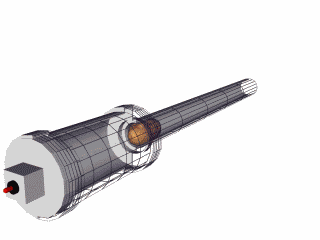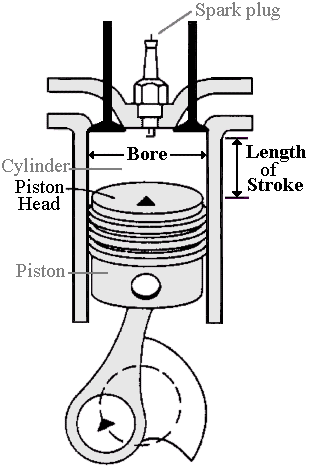Results 1 to 10 of 78
-
February 19th, 2005 08:11 AM #1
GUYS and GALS,
I've been searching the tsikot library of forums and ironically, there hasn't been any straightforward topic concentrated on the basics about engines. I know most of us are already aware how engine works but its good to share and educate the uninitiated. I know that most of you might find this irrelevant since you are educated about cars and engines, but not everyone is REALLY aware about how car engines work and other complex mechanisms found on cars. I'm also trying to re-educate myself to update my knowledge about engines as well.
My source is HOWSTUFFWORKS.COM if you want to read directly from the website.
-
February 19th, 2005 08:13 AM #2
HOW CAR ENGINES WORK??
Have you ever opened the hood of your car and wondered what was going on in there? A car engine can look like a big confusing jumble of metal, tubes and wires to the uninitiated.

-
February 19th, 2005 08:16 AM #3
[SIZE=3]The Basics[/SIZE]
The purpose of a gasoline car engine is to convert gasoline into motion so that your car can move. Currently the easiest way to create motion from gasoline is to burn the gasoline inside an engine. Therefore, a car engine is an internal combustion engine -- combustion takes place internally. Two things to note:
* There are different kinds of internal combustion engines. Diesel engines are one form and gas turbine engines are another. See also the articles on Hemi engines, rotary engines and two-stroke engines. Each has its own advantages and disadvantages.
* There is such a thing as an external combustion engine. A steam engine in old-fashioned trains and steam boats is the best example of an external combustion engine. The fuel (coal, wood, oil, whatever) in a steam engine burns outside the engine to create steam, and the steam creates motion inside the engine. Internal combustion is a lot more efficient (takes less fuel per mile) than external combustion, plus an internal combustion engine is a lot smaller than an equivalent external combustion engine. This explains why we don't see any cars from Ford and GM using steam engines.

Almost all cars today use a reciprocating internal combustion engine because this engine is:
* Relatively efficient (compared to an external combustion engine)
* Relatively inexpensive (compared to a gas turbine)
* Relatively easy to refuel (compared to an electric car)
These advantages beat any other existing technology for moving a car around.
-
February 19th, 2005 08:18 AM #4
[SIZE=3]Combustion Is Key[/SIZE]
To understand the basic idea behind how a reciprocating internal combustion engine works, it is helpful to have a good mental image of how "internal combustion" works. One good example is an old Revolutionary War cannon. You have probably seen these in movies, where the soldiers load the cannon with gun powder and a cannon ball and light it. That is internal combustion, but it is hard to imagine that having anything to do with engines.
A more relevant example might be this: Say that you took a big piece of plastic sewer pipe, maybe 3 inches in diameter and 3 feet long, and you put a cap on one end of it. Then say that you sprayed a little WD-40 into the pipe, or put in a tiny drop of gasoline. Then say that you stuffed a potato down the pipe. Like this:

What is interesting, and the reason we are talking about such a device, is that a potato cannon can launch a potato about 500 feet through the air! There is a huge amount of energy in a tiny drop of gasoline.
-
February 19th, 2005 08:28 AM #5
[SIZE=3]INTERNAL COMBUSTION[/SIZE]
The potato cannon uses the basic principle behind any reciprocating internal combustion engine: If you put a tiny amount of high-energy fuel (like gasoline) in a small, enclosed space and ignite it, an incredible amount of energy is released in the form of expanding gas. You can use that energy to propel a potato 500 feet. In this case, the energy is translated into potato motion. You can also use it for more interesting purposes. For example, if you can create a cycle that allows you to set off explosions like this hundreds of times per minute, and if you can harness that energy in a useful way, what you have is the core of a car engine!

Almost all cars currently use what is called a four-stroke combustion cycle to convert gasoline into motion. The four-stroke approach is also known as the Otto cycle, in honor of Nikolaus Otto, who invented it in 1867.

Last edited by cyberdoc95; February 19th, 2005 at 11:03 AM.
-
February 19th, 2005 08:32 AM #6
[SIZE=3]The Intake Stroke:[/SIZE]
On the intake stroke, the intake valve has opened. The piston is moving down, and a mixture of air and vaporized fuel is being pushed by atmospheric pressure into the cylinder through the intake valve port.

[SIZE=3]The Compression Stroke:[/SIZE]
After the piston reaches the lower limit of its travel, it begins to move upward. As this happens, the intake valve closes. The exhaust valve is also closed, so the cylinder is sealed. As the piston moves upward, the air/fuel mixture is compressed. On some small high compression engines, by the time the piston reaches the top of its travel, the mixture is compressed to as little as one-tenth its original volume. Thus, the compression of the air/fuel mixture increases the pressure in the cylinder. The compression process also creates the air/fuel mixture to increase in temperature.

-
February 19th, 2005 08:36 AM #7
[SIZE=3]The Power Stroke:Power Stroke Image[/SIZE]
As the piston reaches the top of its travel on the compression stroke, an electric spark is produced at the spark plug. The ignition system delivers a high voltage surge of electricity to the spark plug to create the spark. The spark ignites the air/fuel mixture. The mixture burns rapidly and cylinder pressure increases to as much as (600psi). All of this pressure against the piston forces it down in the cylinder. The power impulse is transmitted down through the piston, through the piston rod (connecting rod), and to the crankshaft. The crankshaft is rotated due to the force.

[SIZE=3]The Exhaust Stroke:[/SIZE]
As the piston reaches the bottom of its travel, the exhaust valve opens. Now, as the piston moves up on the exhaust stroke, it forces the burned gases out of the cylinder through the exhaust port. When the piston reaches the top of its travel, the exhaust valve closes, and the intake valve opens. The cycle repeats again with the intake stroke. The four strokes are continuously repeated during the operation of the engine.

-
February 19th, 2005 08:44 AM #8
[SIZE=3]Counting cylinders[/SIZE]
The core of the engine is the cylinder, with the piston moving up and down inside the cylinder. The engine described above has one cylinder. That is typical of most lawn mowers, but most cars have more than one cylinder (four, six and eight cylinders are common). In a multi-cylinder engine, the cylinders usually are arranged in one of three ways: inline, V or flat (also known as horizontally opposed or boxer), as shown in the following figures.


Last edited by cyberdoc95; February 19th, 2005 at 09:05 AM.
-
February 19th, 2005 08:49 AM #9
[SIZE=3]DISPLACEMENT:[/SIZE]
The combustion chamber is the area where compression and combustion take place. As the piston moves up and down, you can see that the size of the combustion chamber changes. It has some maximum volume as well as a minimum volume. The difference between the maximum and minimum is called the displacement and is measured in liters or CCs (Cubic Centimeters, where 1,000 cubic centimeters equals a liter).
Here are some examples:
* A chainsaw might have a 40 cc engine.
* A motorcycle might have a 500 cc or a 750 cc engine.
* A sports car might have a 5.0 liter (5,000 cc) engine.
Most normal car engines fall somewhere between 1.5 liter (1,500 cc) and 4.0 liters (4,000 cc)
If you have a 4-cylinder engine and each cylinder displaces half a liter, then the entire engine is a "2.0 liter engine." If each cylinder displaces half a liter and there are six cylinders arranged in a V configuration, you have a "3.0 liter V-6."
Generally, the displacement tells you something about how much power an engine can produce. A cylinder that displaces half a liter can hold twice as much fuel/air mixture as a cylinder that displaces a quarter of a liter, and therefore you would expect about twice as much power from the larger cylinder (if everything else is equal). So a 2.0 liter engine is roughly half as powerful as a 4.0 liter engine.
You can get more displacement in an engine either by increasing the number of cylinders or by making the combustion chambers of all the cylinders bigger (or both).

The piston displacement is found by multiplying the area of the piston head (whose diameter is called the bore) by the height of the cylinder (i.e., length of the stroke)

Last edited by cyberdoc95; February 19th, 2005 at 11:42 AM.
-
February 19th, 2005 08:59 AM #10
[SIZE=3]OTHER PARTS OF THE ENGINE:[/SIZE]
[SIZE=3]
An internal combustion engine[/SIZE]
Spark plug
The spark plug supplies the spark that ignites the air/fuel mixture so that combustion can occur. The spark must happen at just the right moment for things to work properly.
Valves
The intake and exhaust valves open at the proper time to let in air and fuel and to let out exhaust. Note that both valves are closed during compression and combustion so that the combustion chamber is sealed.
Piston
A piston is a cylindrical piece of metal that moves up and down inside the cylinder.
Piston rings
Piston rings provide a sliding seal between the outer edge of the piston and the inner edge of the cylinder. The rings serve two purposes:
* They prevent the fuel/air mixture and exhaust in the combustion chamber from leaking into the sump during compression and combustion.
* They keep oil in the sump from leaking into the combustion area, where it would be burned and lost.
Most cars that "burn oil" and have to have a quart added every 1,000 miles are burning it because the engine is old and the rings no longer seal things properly.
Connecting rod
The connecting rod connects the piston to the crankshaft. It can rotate at both ends so that its angle can change as the piston moves and the crankshaft rotates.
Crank shaft
The crank shaft turns the piston's up and down motion into circular motion just like a crank on a jack-in-the-box does.
Sump
The sump surrounds the crankshaft. It contains some amount of oil, which collects in the bottom of the sump (the oil pan).




 Reply With Quote
Reply With Quote


AFAIK the corolla cross hybrid always had the option of either NiHM or lithium for its HV...
Yaris Cross 1.5 S HEV CVT vs BYD Sealion 6 DM-i